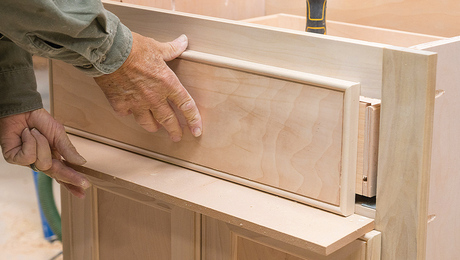Exterior finish choices for 4″ eps foam that is attached to CMU block wall
Would like to know what my choices would be for exterior finish over extruded polystyrene glued / bonded to concrete block wall
Thanks
Ken
Edited 5/23/2007 10:33 pm by OTP
Edited 5/23/2007 10:33 pm by OTP



















Replies
can you say EFIS........
Yes I can, but I wanted an option of finishing it myself
Any one use PermaCrete product
http://www.permacrete.com/brochure.pdf
Edited 5/23/2007 11:25 pm by OTP
who says you can't do EFIS yourself?
You can finish it yourself. Any number of vendors will sell you the material. You can also add shapes to whatever you already have as a foam application. The shapes or mouldings can be off the shelf or custom cut. The foam fabricators can prefinish these mouldings with any number of textures so you don't have to do it all yourself. If you get an opportunity check out the process.
The coatings are not limited to EFIS applications.
What about attaching vinyl siding with 3 1/2†coarse deck screws?
They would only be screwed in to the foam, but at 3 ½ Or gluing ¼ plywood furring strips every two feet then screwing through both
Is there a pull out spec for nails when attaching vinyl siding to wood substrate?
How about thin brick or ceramic tile
Ken
What about attaching vinyl siding with 3 1/2†coarse deck screws?They would only be screwed in to the foam, but at 3 ½ Or gluing ¼ plywood furring strips every two feet then screwing through bothIs there a pull out spec for nails when attaching vinyl siding to wood substrate?How about thin brick or ceramic tile
Everything you just said here will make the hair stand up on every person on this board.
How does 4" thick foam installed over your block foundation interface with the point where your foundation ends and your framing begins ?
Can you post a photo of this ?
carpenter in transition
Ok, I might be crazy
The house will have a 30 x 40 foot print, with loft
Slab foundation with concrete pier’s 18†x 12’ deep every 8 feet, or post tension cable per engineering report based on my soil heavy clayWalls
Dry stack CMU walls with every core filled with grout
http://www.vobb.com/index.htm
Or regular CMU using Mason bond then poured solid with grout
http://www.itwtacc.com/masonry.htmlUsing the Oak Ridge National Laboratory (ORNL) whole wall ORNL Thermal Mass interactive Calculator
http://www.ornl.gov/sci/roofs+walls/AWT/InteractiveCalculators/tmassinfo.htm
By using the thermal mass of the concrete and by insulating the exterior I can have HVAC savings based on the amount / thickness of EXP extruded polystyrene I place on the exterior of the block wall
One Inch R-4 = 8%
Two inches R-8 = 13%
Three inches R-12 = 15%
Four inches R-16 = 17%Theses savings will be on top of the savings I will have by having a tight building envelopeIntier wall finish will be American Clay Plaster
http://www.americanclay.com/index.htmlRoofing
The roof will be SIP’s or trusses sprayed with foam insulation,
I have not decided on using open or closed cell foam insulation
It will come down the strengths and weakness of each system and $$$
Finished off with sheet steel panel roofingSoooo I am looking for options to finish off the EXP foamI brought up the vinyl siding because whether you are attaching the siding with nails or staples
There has to be a pull out failure figure on both nails and staples, how many pounds of force till they fail
Not shear force but dead load pounds straight pull until they pop out EFIS is the obvious choice; I was just asking if there were any other choices
Please poke holes in my plan so I can overcome them now
Ken
Drainage plane? Unless you use an adhesive system you will have to mechanically fasten the insulation, if you have no drainage plane how do you waterproof the opening?
Milburn
I was thinking about doing something like your walls for my shop, only using only 2" of foam board rather than 4", which might simplify fastening. I was thinking about gluing lath spacers to the insulation board (just to hold them in place temporarily) and then using HardiPanel cement board with special long screws into the CMU. I was then going to use 1"x2" trim to do a board and batton which would cover the seams and give four battons per 4 foot panel width. I think that Certainteed has some similar panels that actually give a more realistic weathered grain pattern.
you've got some keys on your keyboard i've never seen before....
yes, EIFS is the obvious choice
windowsills and other openings will require extreme attention.
consider this:
http://files.buildsite.com/dbderived-f/johnsmanville/derived_files/derived153291.pdf
the exterior sheathing gets you the nailing surface for siding which is much less expensive than EIFS. the R-value noted beats the numbers in your post.
the product is also available vented for roofs.
carpenter in transition
Thanks for the reminder of the nail base insulation, good idea using it as a nail base for a wallI had priced SIP’s in my area aprox. $4.50 delivered price per square foot of panel area. I will have to check on a price for the nail base.I believe the window instillation detail on any wall system would be critical.
Infiltration of water and water vapor will cause problems for any break in the building envelope, whether it is a dryer vent, door, or window in all wall types. From my reading, the problem with EIFS is residential and instillation details.
EIFS does not seem to have the same problems in commercial building installations.Maybe the question should be, what is best way to finish esp foam when used in a wall systemKen
eps and extruded polystyrene are not the same...
might make a difference with whatever finish you use...
I wish I knew how to insert an annoying Martha Stewart Banner in my tagline....